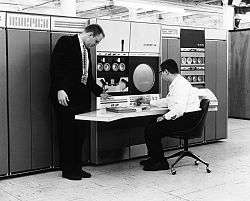PDP-6


The PDP-6 (Programmed Data Processor-6) was a computer model developed by Digital Equipment Corporation (DEC) in 1963.[1] It was influential primarily as the prototype (effectively) for the later PDP-10; the instruction sets of the two machines are almost identical.
Hardware Architecture
The PDP-6 was DEC's first "big" machine. It used 36-bit words, in common with other large computers at the time from companies like IBM, Honeywell and General Electric. Addressing remained 18-bit, as in earlier DEC machines, allowing for a 256 kword main memory. Memory was implemented using magnetic cores; a typical system included 32,768 words (equivalent to 144kB on modern machines).
The instruction set architecture could be categorized as "one-and-a-half address"; instructions contained one full 18-bit memory address, and a second four-bit address that could specify one of the first sixteen memory locations as an "accumulator" or "AC". Another four-bit field in the instruction allowed for any AC other than AC0 to be used as an index register.
Most, if not all, PDP-6 systems were equipped with the optional Type 162 "Fast Memory", which provided 16 memory locations constructed from discrete-transistor flip-flops. The Fast Memory (also known as "fast accumulators" or "fast ACs") substituted for the first 16 words of core memory and operated four times faster.
Construction
The PDP-6 was infamous because of the 6205 board, a large (11 × 9 inches) board which contained 1 bit of arithmetic register (AR), memory buffer (MB), and multiplier-quotient register (MQ) (thus there were 36 of these). It had 88 transistors, a two-sided PC etch, two 18-pin and two 22-pin connectors (two on each side of the module). Because of all these connectors, swapping this module was a major undertaking, and the mechanical coupling made it highly likely that fixing one fault would cause another. There was also a great fear of powering off a PDP-6, since it would generally result in at least one 6205 board failing. The experience with the 6205 led the designers of the first models of PDP-10, the KA10 and KI10, to use only small boards. It was not until the KL10 that large boards were used again.
Operating System Software
The PDP-6 supported time sharing through the use of a status bit selecting between two operating modes ("Executive" and "User", with access to I/O, etc., being restricted in the latter), and a single relocation/protection register which allowed a user's address space to be limited to a set section of main memory (a second relocation/protection register for shareable "high segments" was added on the PDP-10). The main operating system used on the machine was an early version of what later became TOPS-10, and several sites made custom versions of the system, which was available in source code form. MIT's ITS operating system also began on the PDP-6.
Although it was possible to Time Share a PDP-6 without a disk drive,[2] configuring it with four dual DECtape drives "could effectively support about 4-6 simultaneous users." The same[3] system, with a single [4] disk drive, resulted in "real time-sharing (and) could easily handle 20-30 users."
Sales history
Worldwide, only 23 PDP-6's were sold,[1]:p.487[5] the smallest number of any DEC machine. It was complex and expensive to build, as well as difficult to install and get operational at the customer's site. Additionally the sales force found the PDP-6 to be a "hard sell". After a short period in the market, DEC let it be known that they were exiting the 36-bit market to concentrate on their smaller machines again. Not long after this, rumors started to spread that they were, in fact, working on a new 36-bit design, which was eventually released as the PDP-10.
DEC management still considered the system useful because those sales were to technical leaders such as universities. That gave DEC a number of advantages, including a foothold in that market, access to advice on future technical direction from a group of advanced and technically knowledgeable users, and finally a source of intelligent young employees as the business grew.
Museum
Stanford's PDP-6 was shown at DECUS in 1984. The machine was transferred to a DEC warehouse after that event. There are no records of this machine being given to the Computer Museum, which was not part of DEC in 1984. In the late 1990s Compaq donated the contents of the DEC internal archives to The Computer Museum History Center. The Fast Memory cabinet from the Stanford PDP-6 was part of that donation. There is no evidence that the modules sold at the Boston computer museum gift shop were from the Stanford PDP-6, nor is there any evidence that the museum had ever had this machine in its possession.
Notes
- 1 2 Bell, C. Gordon; Mudge,, J. Craig; McNamara, John E. (1978). COMPUTER ENGINEERING: A DEC View of Hardware Systems Design. Bedford, Mass.: Digital Press. ISBN 0932376002.
- ↑ DEC TIMESHARING (1965), by Peter Clark, The DEC Professional (magazine), VOLUME 1, Number 1
- ↑ 64K words
- ↑ RP02
- ↑ http://research.microsoft.com/~gbell/Digital/timeline/1964-1.htm
References
- Bell, C. Gordon, Mudge, J. Craig, McNamara John E. "The PDP-10 Family". (1979). Part V of Computer Engineering: A DEC View of Hardware Systems Design. Digital Equipment Corp.
External links
- DEC PDP-6 Serial numbers
- DEC's PDP-6 was the world's first commercial time-sharing system Gordon Bell interview at the Smithsonian
- http://www.inwap.com/pdp10/usenet/pdp6
- http://research.microsoft.com/~gbell/Digital/timeline/1964-1.htm
- http://research.microsoft.com/~gbell/Digital/timeline/1964-2.htm
- The PDP-6 at Stanford
- Tom Knight's PDP-6 pages